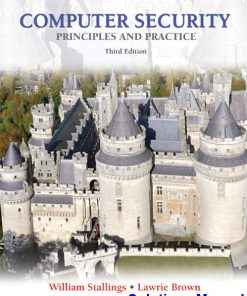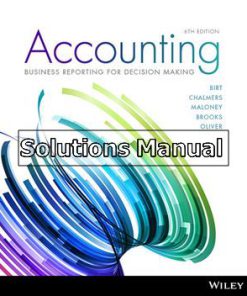Computer Security Principles And Practice 2nd Edition Stallings Solutions Manual
$26.50$50.00 (-47%)
Computer Security Principles And Practice 2nd Edition Stallings Solutions Manual.
You may also like
Computer Security Principles And Practice 2nd Edition Stallings Solutions Manual

Product details:
- ISBN-10 : 0132775069
- ISBN-13 : 978-0132775069
- Author: Dr. William Stallings
Computer Security: Principles and Practice, 2e, is ideal for courses in Computer/Network Security.
In recent years, the need for education in computer security and related topics has grown dramatically – and is essential for anyone studying Computer Science or Computer Engineering. This is the only text available to provide integrated, comprehensive, up-to-date coverage of the broad range of topics in this subject. In addition to an extensive pedagogical program, the book provides unparalleled support for both research and modeling projects, giving students a broader perspective.
Table contents:
Chapter 1 Overview
1.1 Computer Security Concepts
1.2 Threats, Attacks, and Assets
1.3 Security Functional Requirements
1.4 Fundamental Security Design Principles
1.5 Attack Surfaces and Attack Trees
1.6 Computer Security Strategy
1.7 Standards
1.8 Key Terms, Review Questions, and Problems
PART ONE COMPUTER SECURITY TECHNOLOGY AND PRINCIPLES
Chapter 2 Cryptographic Tools
2.1 Confidentiality with Symmetric Encryption
2.2 Message Authentication and Hash Functions
2.3 Public-Key Encryption
2.4 Digital Signatures and Key Management
2.5 Random and Pseudorandom Numbers
2.6 Practical Application: Encryption of Stored Data
2.7 Key Terms, Review Questions, and Problems
Chapter 3 User Authentication
3.1 Digital User Authentication Principles
3.2 Password-Based Authentication
3.3 Token-Based Authentication
3.4 Biometric Authentication
3.5 Remote User Authentication
3.6 Security Issues for User Authentication
3.7 Practical Application: An Iris Biometric System
3.8 Case Study: Security Problems for ATM Systems
3.9 Key Terms, Review Questions, and Problems
Chapter 4 Access Control
4.1 Access Control Principles
4.2 Subjects, Objects, and Access Rights
4.3 Discretionary Access Control
4.4 Example: UNIX File Access Control
4.5 Role-Based Access Control
4.6 Attribute-Based Access Control
4.7 Identity, Credential, and Access Management
4.8 Trust Frameworks
4.9 Case Study: RBAC System for a Bank
4.10 Key Terms, Review Questions, and Problems
Chapter 5 Database and Data Center Security
5.1 The Need for Database Security
5.2 Database Management Systems
5.3 Relational Databases
5.4 SQL Injection Attacks
5.5 Database Access Control
5.6 Inference
5.7 Database Encryption
5.8 Data Center Security
5.9 Key Terms, Review Questions, and Problems
Chapter 6 Malicious Software
6.1 Types of Malicious Software
6.2 Advanced Persistent Threat
6.2 Propagation — Infected Content – Viruses
6.3 Propagation — Vulnerability Exploit – Worms
6.4 Propagation — Social Engineering — SPAM E-Mail, Trojans
6.5 Payload — System Corruption
6.6 Payload — Attack Agent — Zombie, Bots
6.7 Payload — Information Theft — Keyloggers, Phishing, Spyware
6.8 Payload — Stealthing — Backdoors, Rootkits
6.9 Countermeasures
6.10 Key Terms, Review Questions, and Problems
Chapter 7 Denial-of-Service Attacks
7.1 Denial-of-Service Attacks
7.2 Flooding Attacks
7.3 Distributed Denial-of-Service Attacks
7.4 Application-Based Bandwidth Attacks
7.5 Reflector and Am
People also search:
computer security principles and practice 2nd edition
computer security principles and practice 2nd edition solution manual pdf
principles of computer security comptia security+ and beyond pdf
ap computer science principles unit 2 practice test
principles of computer security comptia security+ and beyond












